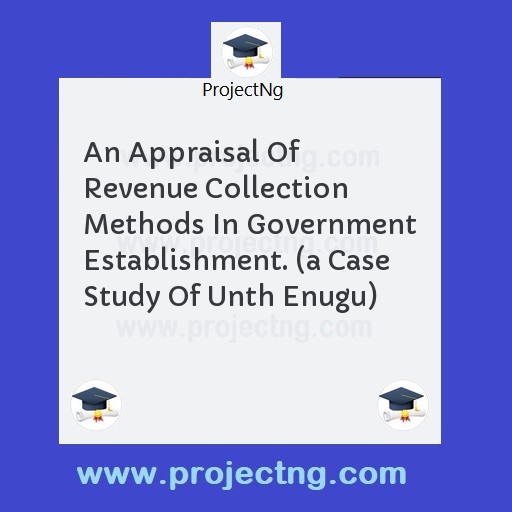An Appraisal Of Revenue Collection Methods In Government Establishment. (a Case Study Of Unth Enugu)
Accounting Project Topics
Get the Complete Project Materials Now! »
AN APPRAISAL OF REVENUE COLLECTION METHODS IN GOVERNMENT ESTABLISHMENT.
(A CASE STUDY OF UNTH ENUGU)
ABSTRACT
Revenue collection method in most government establishment has over the years been the bane of the old Anambra State government in achieving optimum internally generated revenue for both recurrent and capital development. This forced the government to dissolve most of her boards and commissions in 1981 as well as set Revenue Commission and of investigation and recovery of government funs and property in 1984. Even this system were also upheld by present Military Government in the effort to increase the revenue base of the government.
Sequel tot he economic hardship affecting the budget speech emphasized that each sate government should diversify its revenue sourange.
Hence, new revenue source were identified such as introducing new products in the catering department, contractors fees, suppliers non-refundable fees, while old revenue sources was increased to meet up with the economic trend. The hospital hopes to collect millions of naira annually from the collection of hospital fees and others from patients.
The survey area was University of Nigeria Teaching Hospital, where 150 questionnaires were administered to the revenue clerks and accounting officers in the hospital. The questionnaire collected information in personal data, maturational devices method of revenue collection.
This study therefore was an attempt to find out how far the university of Nigeria Teaching Hospital, Enugu method of revenue collection achieved the objectives of the hospital. The study sought answers to questions on the methods of collections.
Based on the findings, the following recommendations were made amongst others:
1. Employment of enough qualitative accounting and revenue clerks
2. Improvement of the accounting system
3. Provision of security escort during lodgments
4. The system of supervisory checks and the role of the internal audit in issuing receipts should be continued.
LIST OF TABLES
1. DIAGRAM OF DAILY REVENUE CASH BOOK
2. DISTRIBUTION ON EDUCATIONAL QUALIFICATION
3. DISTRIBUTION OF SALARY GRADE LEVEL
4. DISTRIBUTION ON DESIGNATION OR RANK
5. DISTRIBUTION ON RISKINESS OF CARRYING CACH
6. DISTRIBUTION ON THE MEDIUM OF PAYMENT
7. DISTRIBUTION ON PAYMET INTO THE BANK
8. DISTRIBUTION ON ACCOUNTING TO THE MAIN CAHIER
9. DISTRIBUTION ON JOB SATISFACTION
10. DISTRIBUTION ON ACCOUNTING EXPERIENCE
11. DISTRIBUTION ON TRAINING PROGRAMME AND FACILITIES
12. DISTRIBUTION ON THE EFFECTIVENESS OF THE COLLECTION SYSTEM
13. DISTRIBUTION ON SECURITY ESCORT
14. DISTRIBUTION ON ACCOUNTING RECORDS
15. DISTRIBUTION ON SUPERVISORY CHECKING
16. DISTRIBUTION ON FINANCIAL MALPRACTIES
TABLE OF CONTENT
PAGE
Title page i
Approval page ii
Dedication iii
Acknowledgement iv
Abstract v
List of tables
Table of contents
CHAPTER ONE: INTRODUCTION
1.1. Background of the study
1.2 statement of problem
1.3 Objective of study
1.4 Scope of study
1.5 Research questions
1.6 significance of the study
1.7 Definition f terms
CHAPTER TWO: REVIEW OF RELATED LITERATURE
1.1 Introduction
2.2 Hospital Accounting system
2.3 Operation f the system
2.4 Revenue assessment and collection methods in the University of Nigeria Teaching Hospital (UNTH)
2.5 Registrations and out-patients procedures
2.6 In-patients assessment and collection methods
2.7 Assessment and collection methods with respect to patient s who died in the Hospital
2.8 Revenue collection methods for staff and other special cases
1.2. Ministerial accounting system
1.3. Accounting records kept by UNTH in relations to revenue collections
1.4. Strategies to ensure effective revenue collections
1.5. The role of Internal Audit in enhancing revenue collections
CHAPTER THREE: RESEARCH METHODOLOGY
3.1 Research design
3.1 Instrument for data collections
3.2 Validity and reliability of measuring instruments
3.3 Population of study
3.4 Sample and campling procedures
3.5 Method of analysis of data
CHAPTER FOUR: PRESENTATION, ANALYSIS AND INTERPRETATIONOF DATA
CHAPTER FIVE
5.1 Summary of findings,
5.2 Recommendation
5.3 conclusion
REFERENCES:
QUESTIONNAIRE:
CHAPTER ONE
1.0 INTRODUCTION
1.1 BACKGROUND OF THE STUDY
There is no doubt that Nigeria is blessed with abundant human and material resources, but the problem with the country is the fact, that is various government since its independence in 1960, some 44 years ago have either inadvertently or otherwise refused to utilize these resources to its benefit.
Unfortunately, the abundance human and material resources of the country was mismanaged and the country thrown into foreign debts today. Since 1984 emphasis has shifted from external borrowing to local or internal sourcing of the country’s revenue for both capital and recurrent expenditure of the government; Federal, States and Local governments.
Also Achebe, Chunua (1985:10) maintained that the dwindling receipt from Federal account owing to sharp drop in the price of crude oil, as a result of global oil glut. Fall in total export earnings from about N4.1 billion in 1980 to N10.5 billion in dwindling export earnings and foreign exchange disbursement on imports escalated.
This resulted in a decrease in the federal government revenue allocation in the states and local governments. In te old Anambra State in particular, the inheritance of a huge debt of about N1.83 billion from he civilian
Be the First to Share On Social

Enjoying our content?
Don't miss out on new videos! Subscribe to our YouTube channel for more awesome content.
Subscribe Now!













